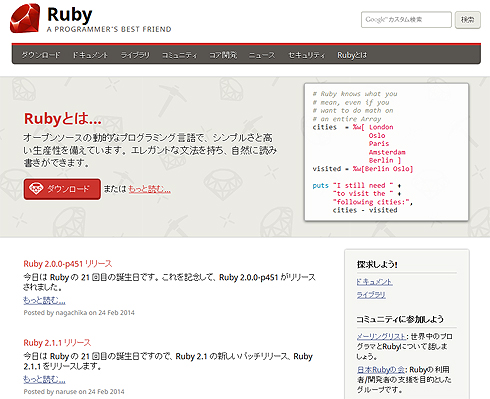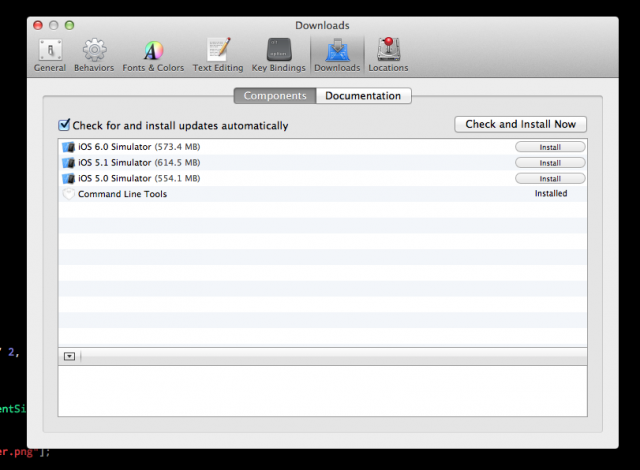The Missing Package Manager for macOS (or Linux). It’s all Git and Ruby underneath, so hack away with the knowledge that you can easily revert your modifications and merge upstream updates. Hidden Homebrew commands Homebrew ships with a whole bunch of commands that don’t show up in brew -help. You can see a list of them in the Homebrew git repo. Each file is named like brew-COMMAND, and you run them with brew command. I recommend brew beer. What’s next If you liked this, I recommend reading through Homebrew’s Tips and Tricks.
This article explains why you should avoid using the version of Ruby bundled with Mac OS X and should instead install your own version of Ruby with RVM, the Ruby Version Manager.
Hands Off the System Ruby
Apple bundles the Ruby programming language with OS X. However, the main caveat for using the bundled version, called the system Ruby, is that Apple bundles Ruby for it’s own use. Therefore, it’s best not to make changes to the system Ruby.
You’ll know when you’re about to change the system Ruby when you need to prefix a gem installation with sudo, for example:
Another reason for not using the system Ruby is that it’s often several versions behind the latest stable version.
The Ruby Version Manager
A better alternative to using the system Ruby is to install Ruby with RVM, the Ruby Version Manager. RVM is a tool for installing different versions of Ruby itself. RVM has the following advantages:
- RVM enables you to install multiple versions of Ruby and allows you to change which version you want to use.
- RVM installs each version of Ruby in a hidden folder in your home folder so each version of Ruby you install doesn’t affect the system Ruby.
- Gems installed by RVM-managed versions of Ruby are installed within the hidden folder in your home folder containing that version of Ruby.
- You won’t need use
sudoto install gems.
To check that you’re currently using the system Ruby, open Terminal and type the following:

If you’re using the system Ruby, OS X will respond with:
You can check which version of Ruby OS X is using with:
Installing RVM and Ruby
The RVM install page has comprehensive instructions for installing RVM that work on Mac OS X. I’ll provide the steps I used here.
The first step is to install the mpapis public key. However, as the install page notes, you might need gpg. Mac OS X doesn’t ship with gpg so before installing the public key, you’ll need to install gpg. I installed gpg with Homebrew:
After you’ve installed gpg, you can install the mpapis public key:
I've listed the mapis public key install command here for illustration. You should use the version on the RVM install page.

I chose to install RVM with the latest stable version of Ruby, which at the time was 2.2.0:
After the installation completes, close the Terminal window and open a new one to make sure that Terminal picks up any environment changes.
Using RVM
You can list the versions of Ruby available to RVM with rvm list:
The rvm use command selects a version of Ruby:
You can check that you’re using an RVM-managed version of Ruby with:
OS X now responds with:
which tells us we’re using version 2.2.0 and that version 2.2.0 has been installed in my home folder away from the system Ruby. You can confirm this by asking Ruby itself with:
The RVM-managed version of Ruby responds with:
As I mentioned earlier, gems installed with RVM-managed versions of Ruby are located with the Ruby. You can check where gems will be installed with:
The following lines of output shows that gems will be installed in the folder XXX.
To find out where a particular gem is installed, use the gem which command. For example, gem which jekyll locates the Jekyll gem:

I can run ruby -v , but cannot run bin/rails generate scaffold...
You probably want to look in /usr/bin/ to find stuff. Assuming RVM was installed properly, you should be check it quickly by running rvm list to see which Rubies RVM is managing. If you need to use a different version install it like this:
rvm install ruby-X.X.X
rvm --default use ruby-X.X.X
You probably already had a random Ruby installed just by having OSX but probably not rails. Since rails is just a gem you can add it with
gem search '^rails$' --all # to find rails versions available to you. Mac cosmetics pro mac makeup pro,mac makeup wholesale.
Homebrew Rom Sets
gem install rails -v rails_version # replace rails_version with the specific version you want, i.e. 5.1.4
Homebrew Rvm Readline
Posting to the forum is only allowed for members with active accounts.
Please sign in or sign up to post.
